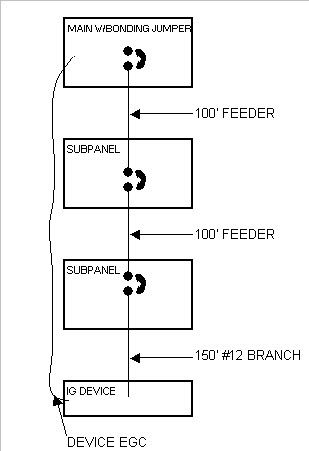tryinghard
Senior Member
- Location
- California
Here?s a visual of a likely scenario. This is why I have trouble accepting isolated ground circuits.



Here?s a visual of a likely scenario. This is why I have trouble accepting isolated ground circuits.

Bob,
The isolated grounding conductor could be a lot longer than the associated branch circuit conductors in the cases where the system bonding jumper or main bonding jumper is not in the same panel as the branch circuit OCPD.
I don't think the code directly addresses the sizing of the isolated grounding conductor in this case.
If equipment manufactures require ground reference it is by their mistake, this is a poor reason to cause hay-wiring of something as important as fault path.
The example I posted may or may not have an overhead served/supplied main but it is the most common in California.
Think about existing situations where new equipment is listed needing these lame requirements and how your going to route the IG.
In my example even if the isolated ground terminates at the main it will need to route beyond its respective phase conductors by over 200’.
It will also require additional conduit this additional distance or be installed through two subpanels with feeders .
They are not bond by the NEC and all data equipment that uses RS-232 type interconnections still use a ground reference.
I find that hard to believe, your drawing indicates that the IG runs all the back to the utility transformer.
How exactly would that be done?
The IG should be run back toward the source and stop at the first point of intentional neutral bonding. In a building without any SDS this point will be the service disocnect enclosure.
In an existing installation your best bet would to make the branch circuit run back to the main panel or back to the first panel on the load side of an SDS. Or run a new feeder from there as you will never be able to sneak an IG in with existing feeders.
You lost me, the IG will be run in the same conduit with the feeders, there is no option to run it outside those raceways.
I don't see any 250.122(B) issues here. You could use the performance requirements in 250.4, backed by calculations to require larger EGC conductors for either a normal or isolated EGC....
I agree but will add it does an equally poor job with a normal EGC.
I am still trying to figure out how 250.122(B) can effect this, it is really not clear.:-?
You would only run the isolated EGC to XO where the system is SDS and the system bonding jumper is installed at the transformer.My point exactly! This drawing reflects what you said in a previous post regarding terminating at the supply XO. Otherwise the example is highly likely (and most common) with multiple panels before branching.
While I agree that the long isolated EGC should be increased in size, I don't see how 250.122(B) applies as the branch circuit conductors for this circuit have not been increased in size and increasing the size of those conductors is the only thing that triggers the application of 250.122(B).Also my point exactly! Applications like these force bizarre installations. Also these type applications should most often cause 250.122(B) to take affect for voltage drop because of lengths.
The only code permitted path for the IG conductor is the raceway or cable that contains the feeder conductors for all of the panels between the main or system bonding jumper and the panel that supplies the IG circuit.If your branch originates at the last subpanel you have to find a way to get your IG to your bonding point, as you now say is at the main in my example.
My point exactly! This drawing reflects what you said in a previous post regarding terminating at the supply XO. Otherwise the example is highly likely (and most common) with multiple panels before branching.
No, not at all, I said it goes back to the XO of an SDS and I certainly did not mean by a route outside the conduits or cables.
...While I agree that the long isolated EGC should be increased in size, I don't see how 250.122(B) applies as the branch circuit conductors for this circuit have not been increased in size and increasing the size of those conductors is the only thing that triggers the application of 250.122(B).
...The only code permitted path for the IG conductor is the raceway or cable that contains the feeder conductors for all of the panels between the main or system bonding jumper and the panel that supplies the IG circuit.

